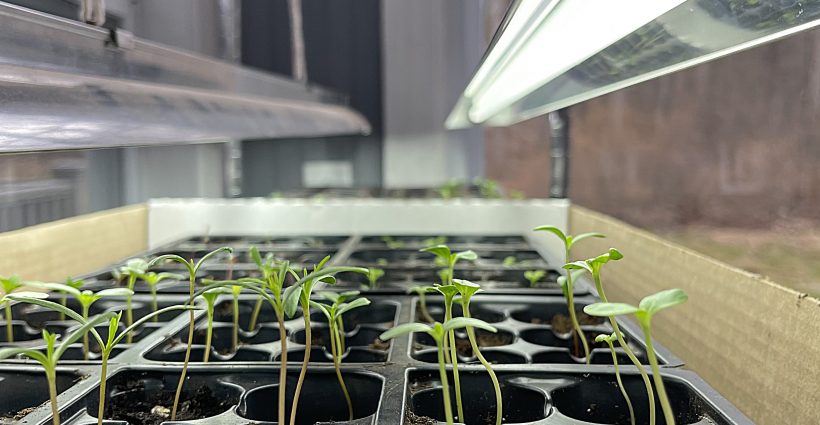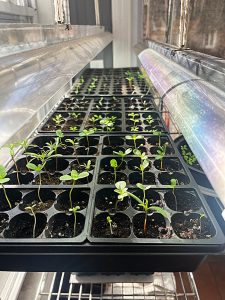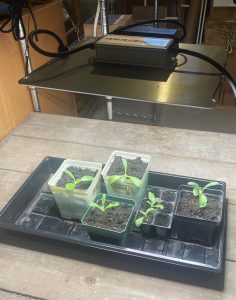designed for the way women work.

Get A Jump Start on Spring Indoors
Category: Flower Gardens, Garden Planning, How-To Projects, Presenting "The Curious Gardener", Spring Projects, Tools & Techniques
At this time of year a little gardening therapy can go a long way. There isn’t much that can be done outdoors where I live in Zone 6 until the ground thaws and dries out a little. But there’s plenty you can be doing indoors, and for me the fun begins with grow lights.
Many houseplants need 12-16 hours of light a day to thrive, and seedlings like 16-18 hours a day. That doesn’t mean that they will die with less light, but this is the optimum. You’ve probably heard of a condition called SAD (seasonally affective disorder) suffered by some people during the winter. Many plants suffer from a similar condition, called PAD (photosynthetically affective disorder). Although the root cause of the disorder for plants and humans is different, the same lights can be used to treat both conditions!
The days are growing longer and plants are in tune with the lengthening of the days and the increased warmth that occurs as our hemisphere starts to tilt towards the sun. But our outdoor growing season, from the last frost in the spring to the first frost in the fall, is on average only about 150 days according to the Old Farmers Almanac. So starting the gardening season a little early indoors can give a head start to our garden and a boost to our mental wellbeing.
When considering lighting for plants there are primarily four issues to consider:
- What colors in the spectrum are being emitted– A full spectrum light source is closest to natural light. Red light encourages flowering while blue light is important for leaf development.
- How hot or intense the light source is– Lighting that is hot to the touch is less desirable for plants because it risks burning them if it’s placed too close.
- How efficiently and economically the light can be operated– Some indoor lights use a lot of power and do not have a long lifespan, while others are the opposite.
- How many hours of darkness your plant wants. Plants need darkness as well as light. Put a timer on your lights so they get the amount of light, and darkness, they need.
Sunlight is the gold standard for lighting plants but it can have limitations as a light source when growing indoors. Natural light coming through the window is not as strong as sunlight outdoors, especially with energy efficient windows. Those same windows insulate against the cold a lot better than their predecessors, but plants placed too close to the glass will suffer at night. Seedlings have a tendency to get leggy in their attempt to reach for the sun, requiring that trays be rotated frequently.
So, here’s what you need to know about artificial lighting options for your plants indoors.
Incandescent Lights. Ordinary household lightbulbs emit more red light, good for encouraging flowering, but they don’t emit blue light, important for leaf development. They are hot to the touch so plants should be kept about a foot from the light source. They are inefficient and you can expect to get only about 1,000 hours out of a single lightbulb.
Fluorescent Lights. Fluorescent bulbs are cool to the touch and have the important blue light for leaf development. If you purchase the whitest fluorescent bulb, or full spectrum, you will get more of the important red color as well. If you are purchasing a Grow Light for plants it will have both the red and blue light in them. Standard tube lights are 4’ long and last for about 10,000 hours.
LED Lights. Although more expensive than fluorescent lights, they are probably the most efficient since the expected lifespan from a bulb is 50,000 hours and they draw very little power. But they often lack red light, so look for ones with red as well as blue light. LED lights are cool to the touch so you don’t have to worry about burning your plants by putting it too close to them.
Halogen Lights. They emit a full spectrum of light but are not efficient and are hot to the touch, like incandescent bulbs.
Here are some of the ways I garden indoors:
- Start seeds indoors under grow lights. I absolutely love visiting the plant ‘nursery’ in the morning to see what’s happened overnight. It’s great therapy!
- Buy small potted plants from garden centers and grow them for a month or so under lights before they can be safely planted outdoors. Very economical!
- Grow an herb garden in the kitchen year round. You can purchase countertop setups for this, or make your own fairly easily. I dislike buying tiny bags of chives that cost $5.95!
- Overwinter large plants indoors that live outside in the summer. If you don’t like the look of white grow lights consider giving your plants a “light vacation” by putting them under a light periodically or moving them to a sunny window once in a while. Mine appreciate it!

Grow light in my basement with Spider Farmer LED lights
For a list of the best grow lights on the market now, according to The Spruce, click here: https://www.thespruce.com/best-grow-lights-4158720


